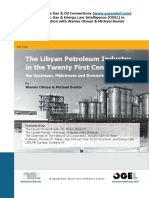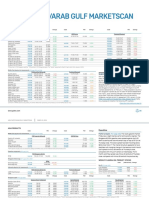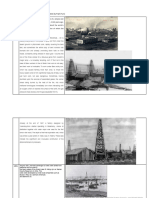Nanotechnology For Petroleum Engineering
Uploaded by
Gregory Anmawen AnisomyaansaCopyright:
Available Formats
Nanotechnology For Petroleum Engineering
Uploaded by
Gregory Anmawen AnisomyaansaOriginal Description:
Original Title
Copyright
Available Formats
Share this document
Did you find this document useful?
Is this content inappropriate?
Copyright:
Available Formats
Nanotechnology For Petroleum Engineering
Uploaded by
Gregory Anmawen AnisomyaansaCopyright:
Available Formats
4th International Conference on Mechanical, Automotive and Materials Engineering (ICMAME'2014) Jan.
28-29, 2014 Bangkok (Thailand)
Significance of Nanotechnology in Oil and Gas
Offshore Engineering
Nader Nabhani, and Milad Emami
mile or more now represent the biggest single new oil
resources for the world communities. Published information
indicates the presence of more than 20% of worlds proven
reserve in offshore geological structures. As per future
production forecast of hydrocarbon resources, about 40 to
50% of future hydrocarbon recovery will be from offshore
reserves [7].
Nanotechnology represents the development and application
of materials, methods and devices, in which critical length
scale is on the order of 1-10 m. Proven a game changer for
AbstractNanotechnology is a science concerned with the
design, construction and utilization of functional structures with at
least one characteristic dimension measured in nanometers.
Presently, nanotechnology are used in a number of industries,
including electronic, materials and manufacturing, aerospace,
photography, construction and more recently the energy industries.
Nanotechnology has the potential to introduce revolutionary changes
in several areas of the oil and gas industries from upstream to
midstream to downstream. This paper present a broad overview of
the application of nanotechnology in the offshore engineering.
KeywordsNanomaterials, offshore, structure
I. INTRODUCTION
HE global demand for energy is anticipated to continue
over the next few decades with the expectation that the
worlds energy consumption will increase by as much 50% in
the next 20 years [1] as shown in figure [1]. This unabated
global demand for energy will translate into growing demand
for traditional hydrocarbon resources since the rate of
alternative energy sources, at least for the next 2 decades, will
be compliment and supplement, rather than replace the
hydrocarbons [2].
Moreover, since as readily accessible hydrocarbon basins
are diminishing quickly and the easily recoverable oil and gas
reserves are declining rapidly, the oil and gas industry are
looking for new reserves of oil and gas every corner of the
earth. According to Shihab-Eldin [3] the average field size of
new discoveries in traditional onshore and offshore areas has
declined from 220 MM BOE per discovery in 1960s to less
than 50 MM BOE in 1990s. As ocean occupies three quarters
of the earth and has high prospect of hydrocarbon resources in
addition to other valuable marine resources [4], there are
increasing activities in the offshore areas with a major focus
on deep water drilling. The decreasing reserve of onshore and
shallow water hydrocarbon basins and high prospect of deep
water basin are the major driving forces in shifting the
industry focus to deep water drilling for oil and gas.
According to Matthew [5] the potential of discovering future
giant oil and gas fields in deep water environments are much
higher than in onshore and shallow water environments.
Leisman [6] also pointed that reserves at depths approaching a
Fig. 1History and projections for global energy use [Energy
Information Administration (2006)].
exploiting fossil-based fuels and, over the next 30 years
nanotechnology will be critical component in developing
fossil-base energy technologies. [8].
The most obvious application of nanotechnology for
offshore operations is developments of better-materials. By
building up such substances on a nanoscale, it could produce
equipment that is lighter, more resistant, and stronger.
This paper examines the potential areas where nanotechnology
can benefit petroleum engineering. The data and information
collected is from current literature. The purpose is to point out
clear cut direction among the nanotechnology development
areas where the petroleum process would immediately harness
nanotechnology, by specifying clear recommendations. The
information would be beneficial to both petroleum engineering
education and research.
II. APPLICATION OF NANOTECHNOLOGY IN OFFSHORE OIL AND
GAS INDUSTRY
Nader Nabhani, Petroleum University of Technology, Abadan, Iran
(corresponding author to provide phone:+98-9163060189; fax:+98-6115551321; E-mail:nabhani@put.ac.ir).
Milad Emami, Petroleum University of Technology, Ahwaz, Iran (Email:
milad_abi1368@yahoo.com).
Compared
to
other
industries,
application
of
nanotechnology is very limited in oil and gas industry and the
20
4th International Conference on Mechanical, Automotive and Materials Engineering (ICMAME'2014) Jan. 28-29, 2014 Bangkok (Thailand)
built environment. However, within the next few decades,
significant improvements are expected in intelligent, cost
effective, durable and environmental friendly materials and
structures since nanotechnology generated products have
many unique characteristics [8,9]. These include product that
are for: lighter structure, stronger structural composites, low
maintenance coating, better properties of cementitious
materials, improving pipe joining materials and techniques,
and reducing the thermal transfer rate of fire retarment and
insulation.
There are large number of applications of nanotechnology
in offshore oil and gas industry. Some of these applications are
examined in detail below.
FeO2 has been reported [13]. It is also been reported that
adding small amount of carbon nanotube (1%) by weight
could increases both the compressive and flexural strength
[16].
V. DRILLING FLUIDS
Drilling fluids are used in drilling operations to cool and
lubricate the drill bit, remove rock debris and drill cutting
from the site and to counteract downhole formation fluids [9].
Current experience shows that, due to unique characteristic
features of nanos compared to the parent materials and their
easy manipulation to perform certain tasks, nanomaterials are
consider to be the one of the best candidates for smart fluids
formation to overcome the poor performance of the
conventional drilling and simulation fluids [9,17,18].
Projects in the Adriatic sea and the gulf of Mexico [19]
have demonstrated that the mixture of seawater and nanobased polymer fluids (which enables high quality fracturing
[20], generate practical fracturing fluids in offshore operation
to enhance production while simplifying the process, saving
time and reducing cost.
Another area where nanomaterial can make impact is with
shallow water flow problem which is frequently encountered
in most of the deepwater drilling (and in some onshore)
operations. It increases the drilling cost significantly [21-22],
due to isolate the SWF zone. It is the most feared to geohazards associated with deepwater drilling and are frequently
encountered in deep water drilling in the southern Caspian sea
and Norwegian sea [22]. It is expected that the nanofluid can
improve some of the challenges such as borehole and sea bed
equipment stability used in offshore drilling and production,
[18].
III. STRUCTURAL COMPOSITES
Steel with various grades, from mild steel to high-strength
steel, is a major construction materials in offshore oil and gas
platforms (in which steel and concrete are the materials for
choice for offshore, with steel dominant in the topside
applications). The properties of steel, such as strength,
corrosion resistance and weld ability are very important for
design and construction.
FHWA together with American Iron and Steel Institute and
the U.S. Navy started to develop new, low carbon, highperformance steel (HPS) for bridges in 1992 [10]. The new
steel was developed with higher corrosion-resistance and weld
ability by incorporating copper nanoparticles from at the steel
grain boundaries. Sandvik NanoflexTM is new stainless steel
with ultra-high strength, good formability, and a good surface
finish developed by sandvik nanoflex Materials Technology.
Due to its high performance, Sandvik NanoflexTM is suitable
for application which requires lightweight and rigid designs.
Its good corrosion and wear resistance can keep life-cycle
costs low. Attractive or wear resistant surfaces can be
achieved by various treatments (Sandvik Namoflex Materials
Technology). MMFX2 is nanostructure modified steel,
produced by MMFX Steel Corp. Compared with the
conventional steel, it has a fundamentally different
microstructure a laminated lath structure resembling
plywood. This unique structure provides MMFX2 steel with
amazing strength (three times stronger), ductility, toughness,
and corrosion resistance. Due to high cost, the stainless steel
reinforcement in concrete structure is limited in high risk
environments. The MMFX2 steel could be an alternative
because it has the similar corrosion resistance to that of
stainless steel, but at a much lower cost (MMFX Steel Corp.).
VI. COATING
The offshore environment is highly-corrosive and special
stresses put additional pressure on the coating systems used
for protection of the steel-structures. Nanotechnology presents
a wide range of opportunities to improve performance of
coatings, and incorporate new performance features. The
coating incorporating certain particles or nanolayer have been
developed to improve the corrosion-resistance, wear
resistance,
shock-resistance
and
enhanced
thermal
conductivity of offshore structures, vessels and drilling
equipment [23-25].
These capabilities will greatly enhanced the ability of
component to produce in more extreme conditions.
Nanocoating will lead to an increase of structural integrity of
offshore structures as well as in service life.
IV. CONCRETE
VII. FUTURE CHALLENGES
Concrete is a constructional material used in oil and gas
production platforms with steel dominant in the topside
application. Addition of nano scale materials into cement
could improve its performance. In this regard, nanoparticles,
especially nanosilica, nano-Fe2O3 [11-14] and nanoalumina
[15] have been widely employed for increasing compressive
and flexural strengths of Portland and Belite cement. Further,
the self monitoring capability of cement mortar with nano
As with most developing technologies, a major number of
challenges exist during the initiation of the application of
technology into reality. Although many achievements with
nanomaterials have been made in laboratory conditions,
serious challenges remain in field implementation for oil
production in complex underground environment. Most
nanomaterial-based products are still in the research and
21
4th International Conference on Mechanical, Automotive and Materials Engineering (ICMAME'2014) Jan. 28-29, 2014 Bangkok (Thailand)
[14] J.Y. Shih, T.P.Chang and T.C.Hsiao, Effect of Nanosilica on
Characterization of Portland Cement Composite, Material Science and
Engineering 424, 266-274 (2006).
[15] I.Campillo, A.Guerrero, J.S.Dolado, J.A.Ibanez and S.Goni,
Improvement of Initial Mechanical Strength by Nanoalumina in Belite
Cement, Materials Letters, 61, 1889-1892 (2007).
[16] S.Mann, Nanotechnology and Construction, Nanoforum Report,
www.nanoforum, May30, 2008.
[17] S.Singh and R.Ahmad, Vital Role of Nanopolymers in Drilling and
Stimulation Fluid Applications, SPE 130413 Presented in 2010 SPE
Annual Technical Conference and Exhibition, Florence, Italy, 19-22
September, 2010.
[18] Md. Amanullah and M.A.Al-Thahini, Nano-Technology-Its Significance
in Smart Fluid Development for the Oil and Gas Field Application,
Technical Symposium and Exhibition, Alkhobar, Saudi Arabia, SPE
126102, May, 2009.
[19] E.Pitoru, D.M.Bradley, H.Nobert Seawater inPolymer-Free Fluids
Optimizes Offshore Fracturing, World Oil, November, 35-43, 2000.
[20] Oil and Gas Eurasia (OGE), Diamond FRAQTM Polymer-free Fluid
Enables
High
Quality
Fracturing,
June
2,
2008.
http:www.oilandgaseurasia.com/news/p/2/news/1762#
[21] G.H.Medley, Shallow Water Flow: A Technology Update, Offshore
Technology Conference, Houston, May5, OTC Paper8731.
[22] D.T.Mueller, Fluids and Techniques for Mitigating deep water drilling
hazards, offshore Mediterranean conference, Ravenna, Italy, March 2426, 1999.
[23] V.Gariby, L.B.Diaz, A.Paniagua. G.E.Palacios, M.F.Vazquez,F.Leyte
and Montensionos, Nanostructured Materials Development with
Applications to Petroleum Industry, Acta Microscopical, Vol.18, No.1,
,52-58,2009.
[24] H.G.Wheat and G.Liu, Using Smart Coatings in Offshore structures, The
Fifteenth International offshore and polar Engineering Conference,
Seoual, Korea, June 19-24, 2005.
[25] Al-Daajani and M.S.Bander Faraj, Corrosion Protection of Carbon-steel
by Aluminum Oxid NanoCoating Using Solution Plasma Spray
Technique, Thesis, King Fahd University (Saudi Arabia), 2012.
development stage in the oil industry. However, very few
nanomaterials-based products have yet to appear in the energy
and petroleum (E&P) technology basket. This can be
contributed to a number of factors [9].
(1) Lake of strong support for innovation in the E&P
sector.
(2) Barriers to entry and adoption.
(3) Perceived cost and risk.
(4) Lake of awareness.
Once solutions to these problem are solved and the relevant
technologies developed, nanotechnologies can be extensively
applied in just about every area of the petroleum industry.
VIII. CONCLUSIONS
The exploration and exploitation of deep water hydrocarbon
resources are associated with a suite of drilling hazards that
are not normally encountered in onshore drilling operations.
Construction of deep water wells, is difficult and expansive,
and the narrowness of the operating pressure window poses
many potential problems, including lost circulation, poor
hole cleaning, stuck pipe, wellbore instability and tough
environmental constraints. Thus deep water drilling requires
the development of new technologies to reduce the drilling
cost, improved safety and minimize environmental impact.
However, from the reviewed literature, nanotechnology offers
many potential solutions to the industry problems that can not
be solved with conventional approaches. Innovations in
nanotechnology as applied to the oil and gas industry will
bring about a technological breakthrough to be industry with
many win-win rewards for both sides.
REFERENCES
[1]
[2]
[3]
[4]
[5]
[6]
[7]
[8]
[9]
[10]
[11]
[12]
[13]
Energy Information Administration, System for the Analysisof global
Energy Markets, Appendix 1 of International Energy outlook 2006.
M.M.Saggaf, A vision for future Upstream Technologies, Journal of
Petroleum Technology (JPT online), March 2008
S.Eldin, New Energy Technology: Trends in the Development of clean
and Efficient Energy forum, Osaka, Japan, 2002.
M.d.Amanullah and L.Tu, Environment Friendly Fluid Loss Additives
to Protect the Marine Environment from Detrimental Effect of Mud
Additives, Journal of petroleum scince and Ehgineering, 48, 199-208
(2005)
R.G.Matthew, A Case of Nanomaterials in Oil and Gas Exploration and
Production Business, International Congress of Nanotechnology, San
Francisco, November 2004.
S.Liesman, Big Oil Starts to Tap Vast Reserves Buried far Blow the
Waves, Wall Street Journal, Juls 3, 2002.
M.d.Amanullah and R.Boyle, Experimental Evaluation of the Formation
Strengthening potential of a Novel Gel System, IADC/SPE Asia Pacific
Drilling Technology Conference (APDT), 13-15 Navember, Bangkok,
Thailand, SPE paper 99491, 2006.
R.Krishnamoori, Extracting the Benefits of Nanotechnology for the Oil
Industry, Journal of Petroleum Technology, 58 (11), 2006.
N.Nabhani, M.Emami and M.Taghavi, Application of Nanotechnology
and Nanomaterials in Oil and Gas Industry, AIP Conference
proceedings, American Institute of Physics, Volume 1415, PP.128-131
(2011).
K.Kuennen, Small Science Will Bring Big Changes to Roods, Better
Roads, 2004.
G.Li, Properties of High Volume Floy Ash Concrete Incorporating
Nano-SiO2 , Cem.Concr.Res.34, 1043-1049 (2004).
G.Z.Xu and G.Song, Effect of Complexation on the Zeta Potential of
Silica Powder, Powder Technology 134, 218-222 (2003).
H.Li, H.G. Xiao and J.Ou, Microstracture of Cement Mortar with NanoParticles, Cement and Concrete Research 34,435-438 (2004)
22
You might also like
- API 6a - 16a Drift Dia For Individual Valves - Christmas Trees and Drill-Through EquipmentNo ratings yetAPI 6a - 16a Drift Dia For Individual Valves - Christmas Trees and Drill-Through Equipment1 page
- Assessment of Impact Damage Causes by Dropped Object On GRP Part1No ratings yetAssessment of Impact Damage Causes by Dropped Object On GRP Part12 pages
- Oil and Governance State-Owned Enterprises and The World Energy Supply100% (2)Oil and Governance State-Owned Enterprises and The World Energy Supply1,059 pages
- Composite Material Offshore Corrosion SolutionsNo ratings yetComposite Material Offshore Corrosion Solutions15 pages
- Cu - Ni Alloy - Electrodeposition and Powder Metallurgy MethodsNo ratings yetCu - Ni Alloy - Electrodeposition and Powder Metallurgy Methods8 pages
- The Use of Protective Weld Overlays in Oil Sands MiningNo ratings yetThe Use of Protective Weld Overlays in Oil Sands Mining10 pages
- Nanocellulose For Oil and Gas Field Drilling and Cementing ApplicationNo ratings yetNanocellulose For Oil and Gas Field Drilling and Cementing Application10 pages
- Nanocomposites - Applications of NanocompositesNo ratings yetNanocomposites - Applications of Nanocomposites8 pages
- Advanced Materials and Protective Coating in Aeroengines ApplicationNo ratings yetAdvanced Materials and Protective Coating in Aeroengines Application10 pages
- Science and Technology Challenges and Potential Game-Changing OpportunitiesNo ratings yetScience and Technology Challenges and Potential Game-Changing Opportunities22 pages
- New Drilling Technologies: Politecnico Di TorinoNo ratings yetNew Drilling Technologies: Politecnico Di Torino51 pages
- Review Report of Blast Resistant Properties of Composite Structures in Naval Vessels.No ratings yetReview Report of Blast Resistant Properties of Composite Structures in Naval Vessels.125 pages
- Enhanced Tribological Properties of Wind Turbine Engine Oil Formulated With Flower-Shaped MoS2 Nano-AdditivesNo ratings yetEnhanced Tribological Properties of Wind Turbine Engine Oil Formulated With Flower-Shaped MoS2 Nano-Additives10 pages
- Towards An Energy Efficient Cement Composite Incorporating Silica Aerogel - A State of The Art Review - 2021No ratings yetTowards An Energy Efficient Cement Composite Incorporating Silica Aerogel - A State of The Art Review - 202117 pages
- 2023 A Reviwe Assessment of Fiber Reinforced Polymers For Maritime ApplicationsNo ratings yet2023 A Reviwe Assessment of Fiber Reinforced Polymers For Maritime Applications12 pages
- Diagnostic and Prognostic Development of A Mechanistic Model Formultiphase Flow in Oil-Gas PipelinesNo ratings yetDiagnostic and Prognostic Development of A Mechanistic Model Formultiphase Flow in Oil-Gas Pipelines9 pages
- Nanotechnology Research and Development in Upstream Oil and GasNo ratings yetNanotechnology Research and Development in Upstream Oil and Gas18 pages
- Concrete As Pelamis Primary Material - KhosraviNo ratings yetConcrete As Pelamis Primary Material - Khosravi10 pages
- Choi - Effect of Welding Parameters On Tungsten Carbide - Metal Matrix Composites Produced by GMAWNo ratings yetChoi - Effect of Welding Parameters On Tungsten Carbide - Metal Matrix Composites Produced by GMAW22 pages
- Comparison of 100 Torr and 200 Torr BPSG Layer Deposited Using Sub Atmospheric Chemical Vapour Deposition (Sacvd) ProcessNo ratings yetComparison of 100 Torr and 200 Torr BPSG Layer Deposited Using Sub Atmospheric Chemical Vapour Deposition (Sacvd) Process9 pages
- Nove Tehnologije Montaže Brodskog Trupa U Brodogradnji: New Technologies For Hull Assemblies in ShipbuildingNo ratings yetNove Tehnologije Montaže Brodskog Trupa U Brodogradnji: New Technologies For Hull Assemblies in Shipbuilding10 pages
- A Nanotechnology Aircraft With Stealth TechnologyNo ratings yetA Nanotechnology Aircraft With Stealth Technology6 pages
- The Applications of Nanotechnology in Civil EngineeringNo ratings yetThe Applications of Nanotechnology in Civil Engineering3 pages
- Laser Cladding of Γ-TiAl Intermetallic Alloy on Titanium Alloy SubstratesNo ratings yetLaser Cladding of Γ-TiAl Intermetallic Alloy on Titanium Alloy Substrates12 pages
- A Comprehensive Review of The Application of Nano-Silica in Oil WellNo ratings yetA Comprehensive Review of The Application of Nano-Silica in Oil Well7 pages
- From Composite Evolution To Vessel Construction Revolution - DNV GLNo ratings yetFrom Composite Evolution To Vessel Construction Revolution - DNV GL10 pages
- Sustainability Assessment of Shielded Metal Arc WeNo ratings yetSustainability Assessment of Shielded Metal Arc We9 pages
- Erosion_Corrosion_Study_of_HVOF_Sprayed_Thermal_SpNo ratings yetErosion_Corrosion_Study_of_HVOF_Sprayed_Thermal_Sp7 pages
- Bitumen in Coating Corrosion ProtectionNo ratings yetBitumen in Coating Corrosion Protection11 pages
- Advancements of Nano-Technology in Civil EngineeringNo ratings yetAdvancements of Nano-Technology in Civil Engineering7 pages
- Ceramics Science and Technology, Volume 4: ApplicationsFrom EverandCeramics Science and Technology, Volume 4: ApplicationsRalf RiedelNo ratings yet
- Oil Refining, Gas Processing, Petrochemicals and Marketing: StrategyNo ratings yetOil Refining, Gas Processing, Petrochemicals and Marketing: Strategy15 pages
- The Libyan Petroleum Industry in The Twenty First CenturyNo ratings yetThe Libyan Petroleum Industry in The Twenty First Century12 pages
- Oilgram Price Report: Valero Makes Big Splash Into MethanolNo ratings yetOilgram Price Report: Valero Makes Big Splash Into Methanol25 pages
- BP's Proposed Findings - Combined FileNo ratings yetBP's Proposed Findings - Combined File1,303 pages
- Daftar Psa Kapal Valid Ytd 17 Juni 2021No ratings yetDaftar Psa Kapal Valid Ytd 17 Juni 202116 pages
- Fuel Pricing Mechanism in India: BY B.RanjaniNo ratings yetFuel Pricing Mechanism in India: BY B.Ranjani10 pages
- RGCE Petroleum Engineering-Result AnalysisNo ratings yetRGCE Petroleum Engineering-Result Analysis13 pages
- Energy Is Referred To As The Basis of Industrial CivilizationNo ratings yetEnergy Is Referred To As The Basis of Industrial Civilization8 pages
- A Very Brief History of Offshore Drilling 06No ratings yetA Very Brief History of Offshore Drilling 067 pages
- Oil & Gas: Transforming Through Digital Technologies: 23 - 25 JULY 2019 Lagos, NigeriaNo ratings yetOil & Gas: Transforming Through Digital Technologies: 23 - 25 JULY 2019 Lagos, Nigeria8 pages

























































































